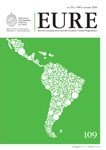Distribution, extent and accessibility of green spaces in Santiago de Chile
DOI:
https://doi.org/10.4067/S0250-71612010000300004Keywords:
social inequality, environmental indicators, urban planning, urban sustainabilityAbstract
Green spaces provide social and ecological functions within urban environments. The magnitude of these depends on the size, distribution and accessibility of such spaces. These attributes of the green areas in Santiago de Chile are evaluated using landscape metrics. The results show that 91% of green spaces are smaller than 5,000 m2. Municipalities with higher population and lower income levels had a greater number of green spaces, but these are smaller than 1,000 m2. The four municipalities with the highest income levels have 32.2% of the total green space surface, while the four municipalities with the lowest income levels barely exceed 4.0%. The proposed accessibility indicator (IAc) reveals that in the La Pintana municipality (low income level), 19.6% of the population has access to a green space of at least 5,000 within 300m from their home, while this figure is 45.3% for San Miguel (medium income level) and 74.1% in Vitacura (high income level). Chilean urban legislation tends to promote the creation of smaller green spaces.Downloads
Published
How to Cite
Issue
Section
License
Copyright (c) 2010 Revista EURE - Revista de Estudios Urbano Regionales

This work is licensed under a Creative Commons Attribution 4.0 International License.
Al momento de aceptar la publicación de sus artículos, los autores deberán formalizar la cesión de derechos de autor a EURE, según las condiciones establecidas por la Revista.
Ésta establece que el autor autoriza a EURE de manera gratuita, exclusiva e ilimitada a reproducir, editar, publicar, distribuir, publicitar, comercializar y traducir el artículo, a cualquier soporte conocido o por conocer y desarrollar.
Del mismo modo, los autores aseguran que el artículo propuesto es original, no publicado y no propuesto para tal fin a otro medio de difusión.


